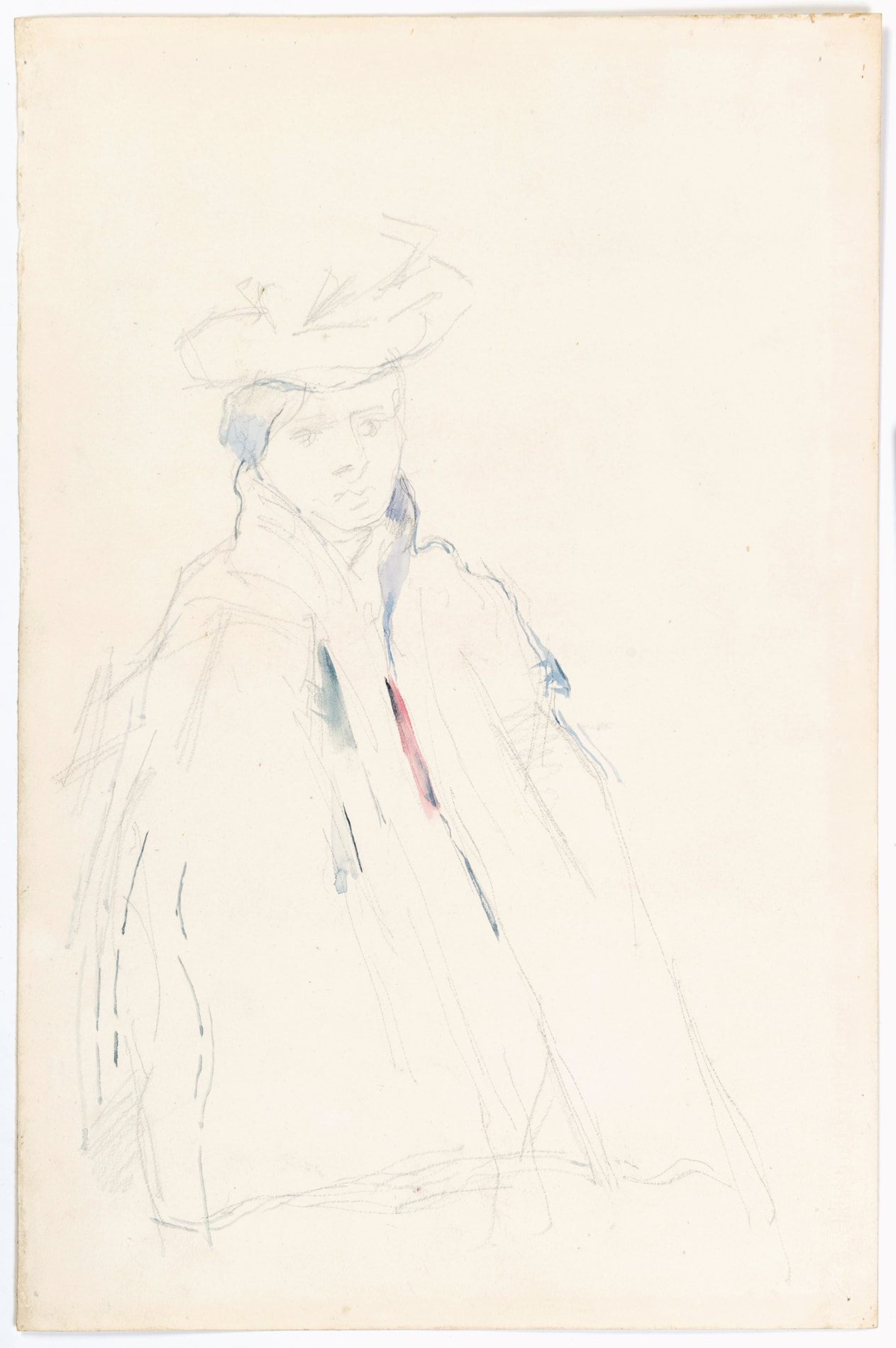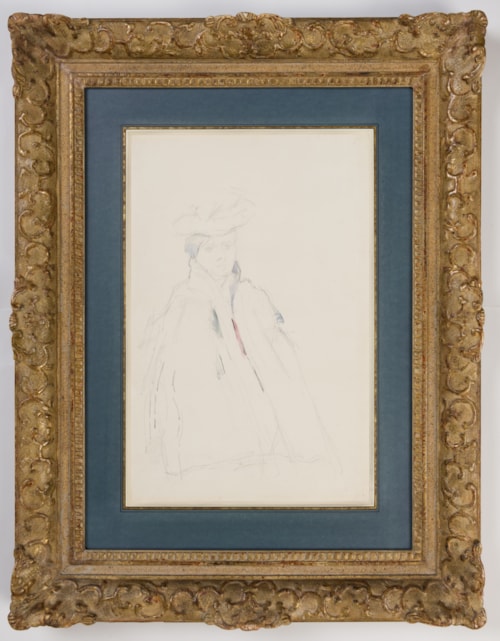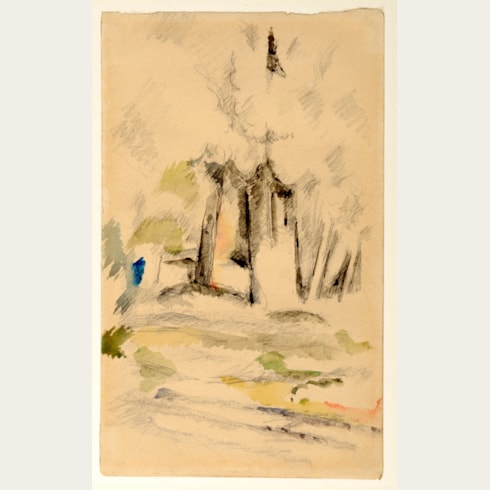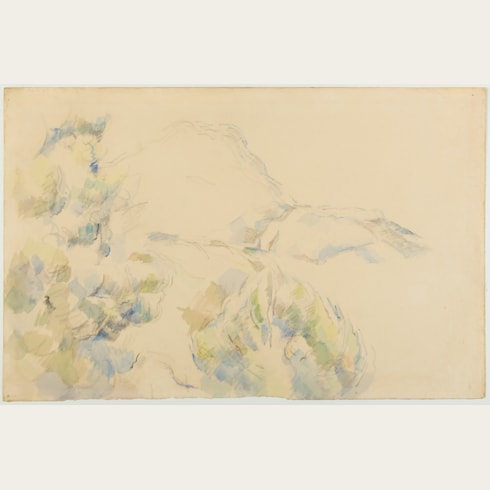Paul CEZANNE
(Aix-en-Provence 1839 - Aix-en-Provence 1906)
Femme à la mante
Watercolour and pencil on white wove paper.
Inscribed La Mante in pencil on the verso.
477 x 315 mm. (18 3/4 x 12 3/8 in.)
Watermark: SAINTE-MARCEL LES ANNONNAY MONTGOLFIER.
Inscribed La Mante in pencil on the verso.
477 x 315 mm. (18 3/4 x 12 3/8 in.)
Watermark: SAINTE-MARCEL LES ANNONNAY MONTGOLFIER.
The art historian Meyer Schapiro has noted of Paul Cézanne's watercolours that ‘It is one of the charms and also a mystery of the arts commonly grouped under the name of painting that a few pencil lines with some added washes of color, hardly filling the surface and made as a preliminary study for what is to be a fully-covered canvas, can possess an intrinsic completeness…We do not have to interest ourselves in the workshop procedure of Cézanne to enjoy these offshoots of his process. Our admiration is independent of curiosity about method and technique, so compelling is the harmony of these incidental stages of his work, a harmony which is not to be confused with the values of an unfinished canvas. These modest notes achieve wholeness through the same operations of choice and perfected habit that determine the order of the most complex composition. Unlike the unfinished picture they say what they were meant to say – if only to the painter himself – and although a watercolor could have said more, they seem to us a perfect achievement as they are.’
While best known for his landscapes, still life subjects and bather compositions, Cézanne produced around 160 portraits out of a total painted oeuvre of slightly less than a thousand canvases. From his oeuvre of watercolours, however, only about twenty portraits are known, almost all of which were done late in his career. As one scholar has pointed out of the artist’s portraits in watercolours, ‘Striking in them is Cézanne’s reluctance to fully develop a face; all subjects are only vaguely characterized in their physiognomic details. He was just as interested in a jacket or a shirt; in any case, the accurate depiction of the features of a face was infinitely more suited to the qualities offered by drawing or oil painting than by the medium of watercolor...In all of the portraits, the subjects’ character is expressed by the reservation of their poses, by their surroundings, by their physical proportions, by their clothing…Once [his wife] Hortense and his son Paul were no longer available as before to serve as models for his countless drawings and paintings, the watercolorist in Aix preferred to rely on local field hands and farmers he had come to value as neighbours…The more familiar with his models the painter was, the less he felt compelled to characterize them.’
The sitter of the present sheet remains unidentified. As the scholar Christopher Lloyd has noted, ‘Many of the models chosen by Cézanne in Aix-en-Provence during his final years were people who worked on the family property at the Jas de Bouffan before its sale in 1899. They are sometimes directly observed as portraits and at others deliberately posed for use in a narrative composition…Cézanne’s late portraiture, therefore, is dominated by those people in Provence with whom he felt most at ease and with whom he was in daily contact…the sitters are certainly not to be designated merely as types and mostly they defy classification. Rather, as with Vincent van Gogh, they reflect the artist’s respect for the dignity of his fellow human beings.’ It has also been noted that, unlike landscape studies, portrait drawings in watercolour on this large scale are rare in Cézanne’s late oeuvre.
The present sheet was one of a group of 187 watercolours acquired, for the sum of 62,000 francs, from Cézanne’s son in March 1907, less than six months after the artist’s death, by the art dealers Ambroise Vollard and Gaston and Josse Bernheim-Jeune. Later that same year the Bernheim-Jeune Gallery mounted the first large public exhibition of Cézanne’s watercolours in their Paris gallery. Femme à la mante was included in Bernheim-Jeune’s second exhibition of Cézanne watercolours two years later, in May 1909, and was later acquired for stock by the Berlin dealer Paul Cassirer, who, like the Bernheim-Jeunes in France, did much to promote the collecting of Cézanne’s watercolours in Germany.
Dr. Jacques Soubies (1880-1940) was a collector of modern art who owned works by Pierre Bonnard, Cézanne, Henri Matisse, Amedeo Modigliani, Chaim Soutine, Henri de Toulouse-Lautrec and other artists.
The Belgian journalist and writer René Gaffé (1887-1968) assembled a fine and varied collection of modern art, particularly of the Dada and Surrealist movements, as well as African and Oceanic art.
While best known for his landscapes, still life subjects and bather compositions, Cézanne produced around 160 portraits out of a total painted oeuvre of slightly less than a thousand canvases. From his oeuvre of watercolours, however, only about twenty portraits are known, almost all of which were done late in his career. As one scholar has pointed out of the artist’s portraits in watercolours, ‘Striking in them is Cézanne’s reluctance to fully develop a face; all subjects are only vaguely characterized in their physiognomic details. He was just as interested in a jacket or a shirt; in any case, the accurate depiction of the features of a face was infinitely more suited to the qualities offered by drawing or oil painting than by the medium of watercolor...In all of the portraits, the subjects’ character is expressed by the reservation of their poses, by their surroundings, by their physical proportions, by their clothing…Once [his wife] Hortense and his son Paul were no longer available as before to serve as models for his countless drawings and paintings, the watercolorist in Aix preferred to rely on local field hands and farmers he had come to value as neighbours…The more familiar with his models the painter was, the less he felt compelled to characterize them.’
The sitter of the present sheet remains unidentified. As the scholar Christopher Lloyd has noted, ‘Many of the models chosen by Cézanne in Aix-en-Provence during his final years were people who worked on the family property at the Jas de Bouffan before its sale in 1899. They are sometimes directly observed as portraits and at others deliberately posed for use in a narrative composition…Cézanne’s late portraiture, therefore, is dominated by those people in Provence with whom he felt most at ease and with whom he was in daily contact…the sitters are certainly not to be designated merely as types and mostly they defy classification. Rather, as with Vincent van Gogh, they reflect the artist’s respect for the dignity of his fellow human beings.’ It has also been noted that, unlike landscape studies, portrait drawings in watercolour on this large scale are rare in Cézanne’s late oeuvre.
The present sheet was one of a group of 187 watercolours acquired, for the sum of 62,000 francs, from Cézanne’s son in March 1907, less than six months after the artist’s death, by the art dealers Ambroise Vollard and Gaston and Josse Bernheim-Jeune. Later that same year the Bernheim-Jeune Gallery mounted the first large public exhibition of Cézanne’s watercolours in their Paris gallery. Femme à la mante was included in Bernheim-Jeune’s second exhibition of Cézanne watercolours two years later, in May 1909, and was later acquired for stock by the Berlin dealer Paul Cassirer, who, like the Bernheim-Jeunes in France, did much to promote the collecting of Cézanne’s watercolours in Germany.
Dr. Jacques Soubies (1880-1940) was a collector of modern art who owned works by Pierre Bonnard, Cézanne, Henri Matisse, Amedeo Modigliani, Chaim Soutine, Henri de Toulouse-Lautrec and other artists.
The Belgian journalist and writer René Gaffé (1887-1968) assembled a fine and varied collection of modern art, particularly of the Dada and Surrealist movements, as well as African and Oceanic art.
Provenance
The estate of the artist
By inheritance to Paul Cézanne fils, Aix-en-Provence and Paris
Part of a group of watercolours acquired from him on 11 March 1907 by the Galerie Bernheim-Jeune et Cie., Paris
Paul Cassirer, Berlin, in 1914
Marx collection, Paris
Anonymous sale, Paris, Hôtel Drouot [Bellier], 15 June 1938, lot 4
Dr. Jacques Soubies, Paris
His posthumous sale, Paris, Hôtel Drouot [de Cagny & Ader], 13 December 1940, lot 3 (sold for 21,100 FF)
René Gaffé, Brussels and Cagnes-sur-Mer
Probably acquired from him by a private collection, France
Anonymous sale, Paris, Christie’s, 23 March 2017, lot 139
Private collection.
By inheritance to Paul Cézanne fils, Aix-en-Provence and Paris
Part of a group of watercolours acquired from him on 11 March 1907 by the Galerie Bernheim-Jeune et Cie., Paris
Paul Cassirer, Berlin, in 1914
Marx collection, Paris
Anonymous sale, Paris, Hôtel Drouot [Bellier], 15 June 1938, lot 4
Dr. Jacques Soubies, Paris
His posthumous sale, Paris, Hôtel Drouot [de Cagny & Ader], 13 December 1940, lot 3 (sold for 21,100 FF)
René Gaffé, Brussels and Cagnes-sur-Mer
Probably acquired from him by a private collection, France
Anonymous sale, Paris, Christie’s, 23 March 2017, lot 139
Private collection.
Literature
Lionello Venturi, Cézanne: Son art - son oeuvre, Paris, 1936, Vol.I, p.276, no.1095, Vol.II, pl.317 (where dated 1895-1900); John Rewald, Paul Cézanne. The Watercolours: A Catalogue Raisonné, London and New York, 1983, p.178, no.383, illustrated fig.383 (where dated 1890-1895); Guy-Patrice and Floriane Dauberville, Cezanne: Paul Cezanne chez Bernheim-Jeune, Paris, 2020, Vol.I, p.95 (installation photograph as exhibited in 1914), p.126 (installation photograph as exhibited in 1931), Vol.II, pp.1092-1093, no.413; Walter Feilchenfeldt, Jayne Warman and David Nash, The Paintings, Watercolors and Drawings of Paul Cézanne: An Online Catalogue Raisonné [www.cezannecatalogue.com], no.FWN 1757 (where dated 1890-1895).
Exhibition
Paris, Galerie Bernheim-Jeune & Cie., Aquarelles & Pastels de Cézanne, H.-E. Cross, Degas, Jongkind, Camille Pissarro, K.-X. Roussel, Paul Signac, Vuillard, 1909, no.2 (‘La femme à la mante.’); London, Grafton Galleries, Second Post-Impressionist Exhibition, 1912, no.172 (‘La femme à la mante (aquarelle)’, lent by Bernheim-Jeune); London, Grafton Galleries, Second Post-Impressionist Exhibition: Re-arrangement, January 1913, no.192 (‘La femme à la mante (aquarelle)’, lent by Bernheim-Jeune); Brussels, La Libre Esthétique, Interprétations du Midi: Exposition de La Libre Esthétique à Bruxelles, 1913, no.53; Paris, Galerie Bernheim-Jeune & Cie., Exposition Cézanne, 1914; Bremen, Kunsthalle Bremen, Internationale Ausstellung, February-March 1914, no.425 (‘Dame im Mantel (Aquarell)’, lent by Bernheim-Jeune and priced at 2,000 Marks); Dresden, Galerie Ernst Arnold, Französische Malerei des XIX. Jahrhunderts, April 1914, no.111 (‘Frau mit Pelerine’); Berlin, Paul Cassirer, Cézanne-Ausstellung. Cézannes Werke in deutschem Privatbesitz: Gemälde, Aquarelle, Zeichnungen, November-December 1921, no.61 (‘Die Frau mit dem Mantel’, lent by Paul Cassirer); Berlin, Galerie Alfred Flechtheim, Cézanne, Aquarelle und Zeichnungen; Bronzen von Edgar Degas, May-June 1927, no.34 (‘La Mante’); Paris, Galerie Bernheim-Jeune & Cie., 6ème Rétrospective Cézanne, May 1931; Paris, Galerie Bernheim-Jeune & Cie., Quarante aquarelles par Cézanne, April - May 1938.







